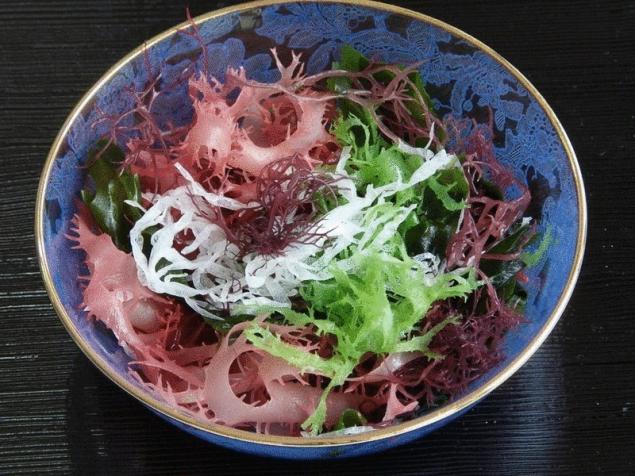532
Algae is a unique product for the recovery
Algae is a relatively young product recovery. Interestingly, their active use began only some fifty years ago. It is now scientifically proven high biological activity of marine flora and high concentration, it is necessary for the substances.
People who regularly consume seaweed, energetic, have a high level of intelligence. They slowly get older and significantly less likely to get sick.

Nutritional value of algae
Despite the fact that each type of seaweed has a unique chemical composition, the representatives of the edible marine life are common features contributing to their nutritional and dietary value. So, seaweed contain vitamins (A, group B, including vitamin B5, or panthenol, C, D, K or menadione, PP, M or folic acid), carotenoids, lipids with polyunsaturated fatty acids, polysaccharides (alginic acid, glucans, pectin, sulfated galactan, fucoidin, lignins are a great source of dietary fiber), macronutrients and trace elements (here the unconditional champion – the iodine, the concentration of which averages 800-1000 mg/kg), derivatives of chlorophyll, plant enzymes, sterols of plant origin, phenolic compounds.
Because seaweed low calorie (average of 7-15 kcal per 100 g), they have every right to consider it a valuable dietary product. So often eat salads with scents of the sea and take them with green tea. The seaweed swells in the stomach and eliminate the feeling of hunger. Use of marine algae of the algae of marine origin are almost endless list of beneficial properties is due to the rich chemical composition.
Anticarcinogenic properties of this product received due to the content of alginates, which selectively bind and deduce from an organism radionuclides, salts of heavy metals, etc. and salts of alginic acid are radioprotectors, defenders from the harmful effects of radiation. These reasons seaweed (kelp) is an excellent preventive remedy against cancer and leukemia.
Antimutagenic activity of algae can be explained by plant pigments such as lutein, chlorophyll and p-carotene. On the mechanisms of action of these pigments today are used by many eminent scientists. The antioxidant properties provides an extensive range of vitamins, slows the aging process.
Anti-inflammatory and antibacterial properties of the marine flora "gave" biologically active components, called immunomodulators. They affect the activity of T-lymphocytes and macrophages, are involved in the synthesis of immunoglobulins. And it was the shortage last in the body the researchers called the main cause of chronic respiratory diseases and urogenital system disorders in the mucous membranes. The synthesis of prostaglandins provide polyunsaturated fatty acids of marine algae, some of which the body is not produced.
Prostaglandins – hormone-like substance found in all tissues (e.g. blood vessel walls), having a stimulating effect on the smooth muscle of the uterus and intestines. Hence the regulation of blood pressure, assistance in fertility and childbirth. No wonder that some prostaglandins used in obstetric practice for the regulation of labor.
Prevention of cardiovascular disease, obesity and diabetes together with the intake of brown seaweed is made possible due to the high concentration in them of fatty acids omega-3 with proven science hypolipidemic properties.
The types of edible seaweed
There are more than 1,000 species of marine algae, of which in the food are not all. And it is not in their possible toxicity. Serious poisoning can only be freshwater algae. However, only some seaweed firmly entrenched in the human diet. What algae are now the most widely used in cooking, and pharmacology (for food additives)?
Kelp or seaweed
Belongs to brown algae, a great source of iodine (rare in organic form), suitable to treat insufficient thyroid function, prevention of endemic goitre, stimulate the metabolism, helps the deposition of salts, of irradiation, multiple sclerosis, obesity (contains fat splitting enzyme).
The concentration of vitamin C, seaweed can compete with citrus fruit. Contraindications: do not eat kelp for tuberculosis and diseases of the kidneys (including pyelonephritis). The greatest benefit you can extract from kelp fresh as vinegar for preservation and production of salads deprives algae of an impressive part of valuable properties. Have certainly read about the popular in the East, a variety of kelp, kelp Arame.
Fucus vesiculosus
Belongs to brown algae, known for its high content of vitamin A (10 g of dried product vs. 100 g carrots), vitamin D (10 g to 10 kg of apricots), iron (10 grams against 1 kg of spinach) and iodine (10 g to 11 kg cod). This type of seaweed has a diuretic effect, removes toxins, stimulates blood circulation, normalizes mineral metabolism. They are identical to the human blood plasma in its chemical composition. Fucoidan – a substance scientists found in seaweeds, has immunomodulatory, antitumor and antiviral activity, including against HIV.
Spirulina
Refers to green algae is very rich in easily digestible protein (per 100 g of the powdery product 60-70 g of protein). And it is three times higher than the protein value of soybeans. Don't forget about the 18 different amino acids, each of which is necessary for a healthy life. And 8 amino acids from this list, the body can not synthesize. Considered one of the most popular edible seaweed. It is sad that fresh it can only afford the inhabitants of the African coast of lake Chad and the Mexicans from Texcoco site natural growth of spirulina. The rest have to settle for biologically active additives and semi-finished products.
The nutritional value of this green algae are so large that it learned to breed in artificial conditions (in huge vats of warm carbon dioxide rich water) in France and Mexico.
Ulva, or sea lettuce
Refers to the green algae have long been used as food by the inhabitants of Ireland, Japan, France, China and Scandinavia. In sea lettuce is high in iron, protein and nutritional fiber.
Porphyry
Refers to red algae prevents the development of atherosclerosis and reduces the body's levels of "bad" cholesterol. This type of algae is recommended for the core as dietary food supplements. Even porphyry rich in vitamins a, B12 and D.
Lithothamnia
Red coral seaweed is a rich mineral composition (it has more than 30 minerals), contains high doses of magnesium and especially iron. For the prevention and healing the body the recommended daily dose of algae is 20 g for fresh, frozen or dried extruded product (Asaka, wakame, nori, etc.).
Attention! Anyone who has kidney problems or thyroid activity before you introduce seaweed into your diet on a regular basis, you should consult with your doctor.
источник:poleznenko.ru
Source: /users/1077
People who regularly consume seaweed, energetic, have a high level of intelligence. They slowly get older and significantly less likely to get sick.

Nutritional value of algae
Despite the fact that each type of seaweed has a unique chemical composition, the representatives of the edible marine life are common features contributing to their nutritional and dietary value. So, seaweed contain vitamins (A, group B, including vitamin B5, or panthenol, C, D, K or menadione, PP, M or folic acid), carotenoids, lipids with polyunsaturated fatty acids, polysaccharides (alginic acid, glucans, pectin, sulfated galactan, fucoidin, lignins are a great source of dietary fiber), macronutrients and trace elements (here the unconditional champion – the iodine, the concentration of which averages 800-1000 mg/kg), derivatives of chlorophyll, plant enzymes, sterols of plant origin, phenolic compounds.
Because seaweed low calorie (average of 7-15 kcal per 100 g), they have every right to consider it a valuable dietary product. So often eat salads with scents of the sea and take them with green tea. The seaweed swells in the stomach and eliminate the feeling of hunger. Use of marine algae of the algae of marine origin are almost endless list of beneficial properties is due to the rich chemical composition.
Anticarcinogenic properties of this product received due to the content of alginates, which selectively bind and deduce from an organism radionuclides, salts of heavy metals, etc. and salts of alginic acid are radioprotectors, defenders from the harmful effects of radiation. These reasons seaweed (kelp) is an excellent preventive remedy against cancer and leukemia.
Antimutagenic activity of algae can be explained by plant pigments such as lutein, chlorophyll and p-carotene. On the mechanisms of action of these pigments today are used by many eminent scientists. The antioxidant properties provides an extensive range of vitamins, slows the aging process.
Anti-inflammatory and antibacterial properties of the marine flora "gave" biologically active components, called immunomodulators. They affect the activity of T-lymphocytes and macrophages, are involved in the synthesis of immunoglobulins. And it was the shortage last in the body the researchers called the main cause of chronic respiratory diseases and urogenital system disorders in the mucous membranes. The synthesis of prostaglandins provide polyunsaturated fatty acids of marine algae, some of which the body is not produced.
Prostaglandins – hormone-like substance found in all tissues (e.g. blood vessel walls), having a stimulating effect on the smooth muscle of the uterus and intestines. Hence the regulation of blood pressure, assistance in fertility and childbirth. No wonder that some prostaglandins used in obstetric practice for the regulation of labor.
Prevention of cardiovascular disease, obesity and diabetes together with the intake of brown seaweed is made possible due to the high concentration in them of fatty acids omega-3 with proven science hypolipidemic properties.
The types of edible seaweed
There are more than 1,000 species of marine algae, of which in the food are not all. And it is not in their possible toxicity. Serious poisoning can only be freshwater algae. However, only some seaweed firmly entrenched in the human diet. What algae are now the most widely used in cooking, and pharmacology (for food additives)?
Kelp or seaweed
Belongs to brown algae, a great source of iodine (rare in organic form), suitable to treat insufficient thyroid function, prevention of endemic goitre, stimulate the metabolism, helps the deposition of salts, of irradiation, multiple sclerosis, obesity (contains fat splitting enzyme).
The concentration of vitamin C, seaweed can compete with citrus fruit. Contraindications: do not eat kelp for tuberculosis and diseases of the kidneys (including pyelonephritis). The greatest benefit you can extract from kelp fresh as vinegar for preservation and production of salads deprives algae of an impressive part of valuable properties. Have certainly read about the popular in the East, a variety of kelp, kelp Arame.
Fucus vesiculosus
Belongs to brown algae, known for its high content of vitamin A (10 g of dried product vs. 100 g carrots), vitamin D (10 g to 10 kg of apricots), iron (10 grams against 1 kg of spinach) and iodine (10 g to 11 kg cod). This type of seaweed has a diuretic effect, removes toxins, stimulates blood circulation, normalizes mineral metabolism. They are identical to the human blood plasma in its chemical composition. Fucoidan – a substance scientists found in seaweeds, has immunomodulatory, antitumor and antiviral activity, including against HIV.
Spirulina
Refers to green algae is very rich in easily digestible protein (per 100 g of the powdery product 60-70 g of protein). And it is three times higher than the protein value of soybeans. Don't forget about the 18 different amino acids, each of which is necessary for a healthy life. And 8 amino acids from this list, the body can not synthesize. Considered one of the most popular edible seaweed. It is sad that fresh it can only afford the inhabitants of the African coast of lake Chad and the Mexicans from Texcoco site natural growth of spirulina. The rest have to settle for biologically active additives and semi-finished products.
The nutritional value of this green algae are so large that it learned to breed in artificial conditions (in huge vats of warm carbon dioxide rich water) in France and Mexico.
Ulva, or sea lettuce
Refers to the green algae have long been used as food by the inhabitants of Ireland, Japan, France, China and Scandinavia. In sea lettuce is high in iron, protein and nutritional fiber.
Porphyry
Refers to red algae prevents the development of atherosclerosis and reduces the body's levels of "bad" cholesterol. This type of algae is recommended for the core as dietary food supplements. Even porphyry rich in vitamins a, B12 and D.
Lithothamnia
Red coral seaweed is a rich mineral composition (it has more than 30 minerals), contains high doses of magnesium and especially iron. For the prevention and healing the body the recommended daily dose of algae is 20 g for fresh, frozen or dried extruded product (Asaka, wakame, nori, etc.).
Attention! Anyone who has kidney problems or thyroid activity before you introduce seaweed into your diet on a regular basis, you should consult with your doctor.
источник:poleznenko.ru
Source: /users/1077
The European space Agency took a fantastic short film
Bryan Cox — aliens no, we are alone in the universe























